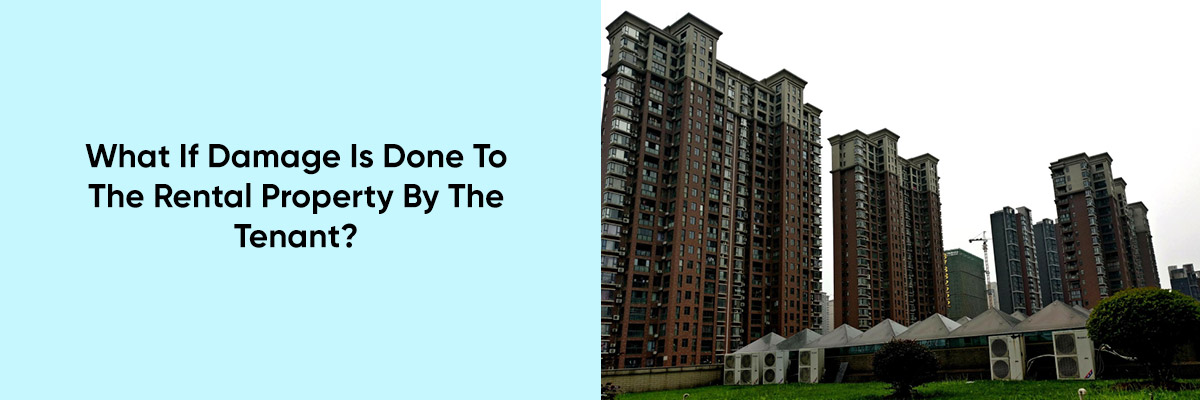The renting of a property can be a mutually beneficial arrangement for both landlords and tenants. There are, however, some risks involved.
Renters may damage landlords’ property, which is one of the worries landlords have. In most cases, landlords cannot charge for the normal wear and tear damages. However, if the damages are severe it can result in financial losses and disputes.
In this blog, we’ll explore the implications of tenant damage to rental properties and how landlords can effectively address and prevent such situations.



Understanding Tenant Damage:
Damage caused by tenants during their occupancy of a rental property is referred to as tenant damage. There are many types of damage, ranging from minor wear and tear to structural damage. Some examples include holes in walls, broken appliances, stains on carpets, and neglect leading to deterioration.
Understanding Landlord’s Rights When a Tenant Damages Property
When a tenant damages your rental property, you have several legal options depending on the severity of the damage and the cooperation of the tenant. Here are some common courses of action:
- Filing an Insurance Claim: If the damage is severe, consider filing a claim with your property insurance provider. Some policies cover tenant-caused damage under specific circumstances.
- Withholding Security Deposit: Landlords can use the tenant’s security deposit to cover repair costs, provided the damage is beyond normal wear and tear. Learn more about the difference between damage and normal wear and tear here.
- Suing the Tenant: If the security deposit is insufficient to cover the cost of repairs, landlords may file a lawsuit to recover the remaining expenses. Documentation and evidence are crucial for a successful claim.
- Eviction: In severe cases of property destruction, landlords may pursue eviction. Learn more about eviction due to property damage in our detailed guide here.
Understanding Legal Implications:
Landlord-tenant laws vary by jurisdiction, but most legal frameworks address the issue of tenant damage. In many places, tenants are legally obligated to maintain the property in a reasonable condition and are liable for any damage beyond normal wear and tear. Landlords, on the other hand, have responsibilities such as providing habitable living conditions and timely repairs. If not done correctly, you might have to bear financial losses. This is why landlords and housing managers need to be aware of the latest fair housing guidelines, and keep a record of all the maintenance work to stay compliant.
How to Handle Different Tenant Damage Scenarios
Different scenarios require different approaches. Here’s how to navigate each situation:
1. If the Tenant Still Lives in the Property
- Communicate Directly: Start with a polite yet firm conversation to address the issue.
- Document the Damage: Take photos, videos, and detailed notes.
- Provide a Repair Notice: Issue a written notice requesting repairs or reimbursement.
- Deduct From Security Deposit: If they refuse to cooperate, consider deducting from their security deposit upon move-out.
2. If the Tenant Is Not Cooperating
- Issue a Formal Notice: Send a formal demand letter outlining the damages and the costs of repair.
- Consider Mediation: Some states offer landlord-tenant mediation services.
- Legal Action: If the tenant still refuses to cooperate, you can file a lawsuit.
3. If the Tenant Has Moved Out
- Conduct a Move-Out Inspection: Document the property’s condition.
- Provide a Damage Report: Notify the tenant of the damage and costs with an itemized statement.
- Deduct From Security Deposit: In most cases, you can deduct repair costs from the security deposit. If the damages exceed the deposit, you can sue the tenant.
- Texas-Specific Rule: In Texas, a landlord typically has 30 days after a tenant moves out to provide an itemized list of deductions and return any remaining security deposit.
Steps for Landlords:
- Document the Condition: Landlords should photograph or write a detailed description of the property before it is rented to a tenant. When disputes arise over damage, this baseline can be used as a guideline for comparison.
- Include Damage Clause in the Lease: In a well-drafted lease agreement, the tenant should be liable for property damage and annual maintenance costs. In the event of severe damage or repeated violations, this can include security deposits, repair costs, and eviction. It is important for landlords to remember that normal wear and tear cannot be deducted from a security deposit.
- Security Deposits: Landlords often require security deposits to protect themselves from tenant damage. These deposits, which are typically equivalent to one or two months’ rent, can be used to cover repair costs at the end of the tenancy. However, landlords must follow legal requirements when handling and reimbursing security deposits.
- Prompt Communication: A landlord should communicate with a tenant immediately and professionally if damage occurs. A written notice detailing the issue and any necessary actions should be given to the tenant after the damage is documented.
- Assessing Damage and Repairs: It is the landlord’s responsibility to assess the extent of the damage and determine the necessary repairs. In minor cases, landlords can handle repairs themselves or hire professionals.
- Legal Recourse: If there is severe damage or dispute over repair costs, landlords may have to take legal action against their tenants. Depending on the circumstances and local laws, this may involve eviction proceedings, small claims court, or mediation.
Preventing Tenant Damage:
While it’s not always possible to prevent tenant damage entirely, landlords can take proactive steps to minimize the risk:
- Screen Tenants: Thoroughly vetting prospective tenants through background checks, references, and rental history can help identify individuals likely to treat the property responsibly. Also, you have to keep in mind that tenant screening is also important in reducing tenant turnover rates.
- Regular Inspections: It is important to conduct periodic property management inspections to allow landlords to identify any maintenance issues or signs of damage early on. It also provides an opportunity to remind tenants of their responsibilities.
- Clear Communication: Establishing clear expectations regarding property maintenance and promptly addressing any concerns or violations can help prevent misunderstandings and minimize damage.
- Maintenance and Upkeep: Proactively maintaining the property, addressing repairs promptly, and keeping it in good condition can discourage tenants from neglecting or causing damage.
To know more about California Tenant Screening Laws in 2025 do give our in-depth blog a read.
End Note:
Dealing with tenant damage is an inevitable aspect of being a landlord, but it doesn’t have to be a nightmare. By understanding their rights and obligations, communicating effectively with tenants, and taking proactive measures to prevent damage, landlords can minimize risks and ensure the long-term integrity and profitability of their rental properties. Ultimately, fostering a positive landlord-tenant relationship built on trust and mutual respect is key to navigating these challenges successfully.


